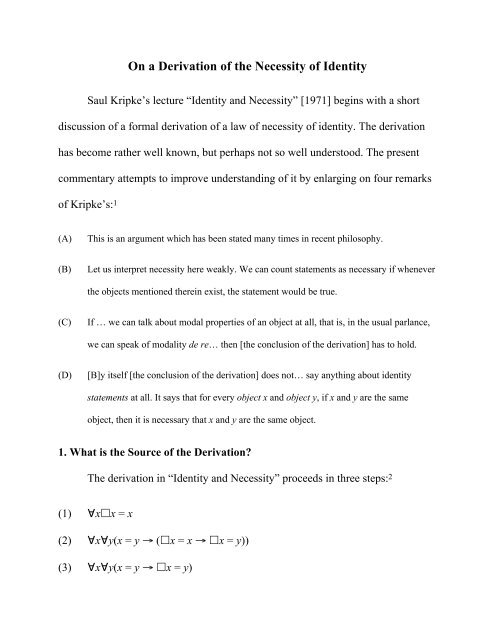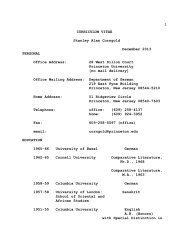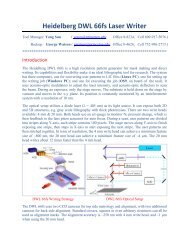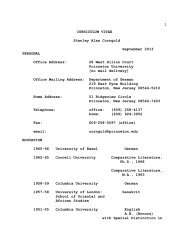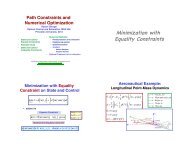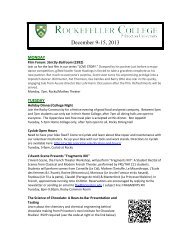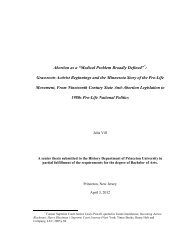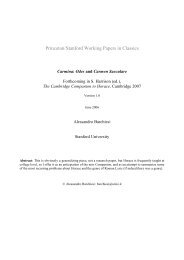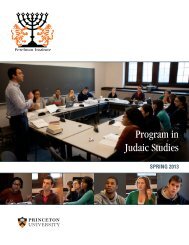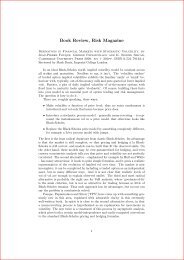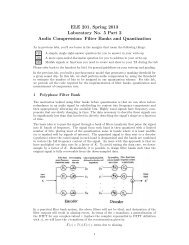On a Derivation of the Necessity of Identity - Princeton University
On a Derivation of the Necessity of Identity - Princeton University
On a Derivation of the Necessity of Identity - Princeton University
Create successful ePaper yourself
Turn your PDF publications into a flip-book with our unique Google optimized e-Paper software.
<strong>On</strong> a <strong>Derivation</strong> <strong>of</strong> <strong>the</strong> <strong>Necessity</strong> <strong>of</strong> <strong>Identity</strong><br />
Saul Kripke’s lecture “<strong>Identity</strong> and <strong>Necessity</strong>” [1971] begins with a short<br />
discussion <strong>of</strong> a formal derivation <strong>of</strong> a law <strong>of</strong> necessity <strong>of</strong> identity. The derivation<br />
has become ra<strong>the</strong>r well known, but perhaps not so well understood. The present<br />
commentary attempts to improve understanding <strong>of</strong> it by enlarging on four remarks<br />
<strong>of</strong> Kripke’s: 1<br />
(A)<br />
This is an argument which has been stated many times in recent philosophy.<br />
(B)<br />
Let us interpret necessity here weakly. We can count statements as necessary if whenever<br />
<strong>the</strong> objects mentioned <strong>the</strong>rein exist, <strong>the</strong> statement would be true.<br />
(C)<br />
If … we can talk about modal properties <strong>of</strong> an object at all, that is, in <strong>the</strong> usual parlance,<br />
we can speak <strong>of</strong> modality de re… <strong>the</strong>n [<strong>the</strong> conclusion <strong>of</strong> <strong>the</strong> derivation] has to hold.<br />
(D)<br />
[B]y itself [<strong>the</strong> conclusion <strong>of</strong> <strong>the</strong> derivation] does not… say anything about identity<br />
statements at all. It says that for every object x and object y, if x and y are <strong>the</strong> same<br />
object, <strong>the</strong>n it is necessary that x and y are <strong>the</strong> same object.<br />
1. What is <strong>the</strong> Source <strong>of</strong> <strong>the</strong> <strong>Derivation</strong>?<br />
The derivation in “<strong>Identity</strong> and <strong>Necessity</strong>” proceeds in three steps: 2<br />
(1) ∀xx = x<br />
(2) ∀x∀y(x = y → (x = x → x = y))<br />
(3) ∀x∀y(x = y → x = y)
Here (1), universal necessary self-identity, is simply postulated. (2) is an instance<br />
<strong>the</strong> axiom scheme <strong>of</strong> <strong>the</strong> indiscernibility <strong>of</strong> identicals from classical identity logic,<br />
also known as substitutivity <strong>of</strong> identicals and as Leibniz’ Law: 3<br />
(4) ∀x∀y(x = y → (Φ(x/z) → Φ(y/z)))<br />
(3) follows by classical predicate logic. 4 The derivation (1)-(3) is one <strong>of</strong> those<br />
things that, though it may appear obvious once pointed out, requires some<br />
ingenuity for its initial discovery.<br />
Kripke makes it clear in remark (A) that <strong>the</strong> ingenuity in question is not to<br />
be attributed to himself. He mentions one earlier source, [Wiggins 1965], but<br />
leaves us wondering: Who first found <strong>the</strong> derivation (1)-(3)? But let us first ask:<br />
Who first found <strong>the</strong> conclusion (3)? More specifically, let us ask after <strong>the</strong> sources<br />
<strong>of</strong> (3) and (1)-(3) in formal systems <strong>of</strong> quantified modal logic.<br />
To begin at <strong>the</strong> beginning, <strong>the</strong> study <strong>of</strong> formal systems <strong>of</strong> quantified modal<br />
logic was launched by three papers that <strong>the</strong> late Ruth Marcus published, under <strong>the</strong><br />
name Ruth Barcan, in <strong>the</strong> Journal <strong>of</strong> Symbolic Logic (JSL) in 1946-47. These<br />
derive from her Yale dissertation, written under <strong>the</strong> supervision <strong>of</strong> Frederic Fitch.<br />
Two systems are developed, based on <strong>the</strong> modal sentential logics S2 and S4. The<br />
first Barcan paper [Marcus 1946a] is best remembered for <strong>the</strong> controversial Barcan<br />
schemes, converse and direct, one given as a <strong>the</strong>orem, <strong>the</strong> o<strong>the</strong>r taken as an axiom.<br />
2
They are usually formulated today as follows:<br />
(5) ∀xΦ → ∀xΦ (6) ∀xΦ → ∀xΦ<br />
The groundwork laid in <strong>the</strong> first two Barcan papers is built upon in <strong>the</strong> third,<br />
[Marcus 1947], which adds second-order apparatus, and presents two main results<br />
about identity.<br />
<strong>On</strong>e main result is <strong>the</strong> equivalence <strong>of</strong> two candidate definitions <strong>of</strong> <strong>the</strong><br />
identity predicate x = y in second-order terms:<br />
(7) ∀X(Xx → Xy) (8) ∀X(Xx → Xy)<br />
Definition (7) is Russell’s, while definition (8), which results from it on replacing<br />
“material implication” by “strict implication” in <strong>the</strong> manner <strong>of</strong> C. I. Lewis, is<br />
Marcus’s. In <strong>the</strong> S2-based system she obtains <strong>the</strong> material equivalence <strong>of</strong> (7) and<br />
(8), and in <strong>the</strong> S4-based system <strong>the</strong>ir strict equivalence. Fitch, in a paper [1949]<br />
that is largely a defense <strong>of</strong> his student’s work, suggests (footnote 3) that <strong>the</strong> failure<br />
to get everything one would want in <strong>the</strong> S2-based system should be taken as an<br />
indication that S2 is inappropriately weak. He in effect suggests working in <strong>the</strong><br />
system T, stronger than S2 but weaker than S4, which has <strong>the</strong> rule <strong>of</strong> necessitation:<br />
(9) from Φ to infer Φ<br />
but not <strong>the</strong> doubling law:<br />
3
(10) Φ ⇔ Φ<br />
T indeed suffices in place <strong>of</strong> S4 for <strong>the</strong> strict equivalence <strong>of</strong> (7) and (8).<br />
The o<strong>the</strong>r main result is a version <strong>of</strong> <strong>the</strong> law <strong>of</strong> necessity <strong>of</strong> identity (3), and<br />
so <strong>the</strong> source <strong>of</strong> <strong>the</strong> conclusion (3) appears to be Marcus. Today, when <strong>the</strong> third<br />
Barcan paper is more <strong>of</strong>ten cited than read, <strong>the</strong>re seems to be a widespread<br />
misimpression that it contains not just <strong>the</strong> conclusion (3), but also <strong>the</strong> derivation<br />
(1)-(3). Even Marcus herself, by four decades later, had formed such an<br />
impression. She forcefully expresses it at <strong>the</strong> beginning <strong>of</strong> her well-known letter on<br />
<strong>the</strong> relationship between her work and Kripke’s: 5<br />
In 1947 in a paper on identity in modal logic in The Journal <strong>of</strong> Symbolic Logic<br />
(12) (JSL), <strong>the</strong>re is a formal pro<strong>of</strong> <strong>of</strong> <strong>the</strong> necessity <strong>of</strong> identity for systems <strong>of</strong><br />
quantified modal logic. It follows in <strong>the</strong> way later represented by Wiggins &<br />
Kripke. I no longer have copies <strong>of</strong> that paper but I enclose a reference from<br />
Hughes and Cresswell Introduction to Modal Logic (1968) (enclosed labelled '1'.)<br />
As in subsequent discussions (Wiggins, Kripke) <strong>the</strong> pro<strong>of</strong> is a straightforward<br />
application <strong>of</strong> <strong>the</strong> indescernibility [sic] <strong>of</strong> identicals and does not depend on any<br />
peculiarly modal assumptions.<br />
Evidently Marcus is here attempting to summarize from memory a paper<br />
published forty years earlier, without having <strong>the</strong> text before her. The attempt, not<br />
very surprisingly, fails: The pro<strong>of</strong> <strong>of</strong> <strong>the</strong> o<strong>the</strong>r main result <strong>of</strong> <strong>the</strong> third Barcan<br />
4
paper, which does invoke indiscernibility, has been confused with <strong>the</strong> pro<strong>of</strong> <strong>of</strong> <strong>the</strong><br />
necessity <strong>of</strong> identity, which does not. The derivation <strong>of</strong> <strong>the</strong> necessity <strong>of</strong> identity in<br />
<strong>the</strong> third Barcan paper is not straightforward, does involve peculiarly modal<br />
assumptions (so that it does not go through for T in place <strong>of</strong> S4), and is altoge<strong>the</strong>r<br />
different from <strong>the</strong> derivation (1)-(3) to be found in Wiggins and <strong>the</strong>n Kripke.<br />
It may be summarized as follows: 6<br />
(11) ∀x∀y(x = y ⇔ ∀X(Xx → Xy))<br />
(12) ∀x∀y(∀X(Xx → Xy) ⇔ ∀X(Xx → Xy))<br />
(13) ∀x∀y(∀X(Xx → Xy) ⇔ ∀X(Xx → Xy))<br />
(14) ∀x∀y(∀X(Xx → Xy) ⇔ ∀X(Xx → Xy))<br />
(15) ∀x∀y(x = y ⇔ x = y)<br />
Here (11) is Marcus’s distinctive definition <strong>of</strong> identity. (12) is an instance <strong>of</strong> <strong>the</strong><br />
two Barcan schemes (5) and (6) (in second-order versions) combined into one. (13)<br />
is an instance <strong>of</strong> <strong>the</strong> S4 doubling law (10). (14) follows from (12) and (13), and<br />
(15) from (11) and (14), by replacement <strong>of</strong> provable equivalents, a meta<strong>the</strong>orem in<br />
most modal systems, but taken as a primitive inference rule in <strong>the</strong> Barcan papers.<br />
So <strong>the</strong> source <strong>of</strong> <strong>the</strong> derivation (1)-(3) appears after all not to be Marcus. It<br />
is, <strong>of</strong> course, <strong>the</strong> rule ra<strong>the</strong>r than <strong>the</strong> exception for <strong>the</strong> first pro<strong>of</strong> <strong>of</strong> a <strong>the</strong>orem to be<br />
superseded eventually by a simpler pro<strong>of</strong> subsequently discovered. In this instance,<br />
5
<strong>the</strong> source <strong>of</strong> <strong>the</strong> simpler pro<strong>of</strong> (1)-(3) appears to be W. V. Quine.<br />
Quine’s first published statements <strong>of</strong> <strong>the</strong> derivation date from 1953, but<br />
<strong>the</strong>re is reason to speculate that he may have arrived at <strong>the</strong> derivation (1)-(3) as<br />
early as 1946, by pondering <strong>the</strong> complicated Barcan derivation (11)-(15) and<br />
asking himself whe<strong>the</strong>r it could be replaced by something simpler. For Quine must<br />
have been one <strong>of</strong> <strong>the</strong> first persons outside Yale to see <strong>the</strong> material in <strong>the</strong> second<br />
and third Barcan papers: When Marcus submitted those papers to <strong>the</strong> JSL, <strong>the</strong><br />
editor, Alonzo Church, assigned <strong>the</strong>m to Quine as referee.<br />
I have been unable to locate his referee’s report in <strong>the</strong> as yet incompletely<br />
catalogued Quine Nachlaß in <strong>the</strong> Houghton Library at Harvard, but Church’s reply<br />
is available to scholars in <strong>the</strong> Church Nachlaß in <strong>the</strong> Firestone Library at <strong>Princeton</strong><br />
(Box 26, Folder 1). From this reply (dated June 9, 1946) one can ga<strong>the</strong>r that<br />
Quine’s report was not encouraging, but that Church as editor was prepared to<br />
overrule his referee. The operative passage reads as follows:<br />
The fact that you point out, that her methods are laborious and <strong>of</strong>ten ra<strong>the</strong>r<br />
obvious, while she seems to avoid <strong>the</strong> more difficult and interesting questions,<br />
leaves me still in doubt whe<strong>the</strong>r we should decline her papers, and I think that I<br />
ought to get ano<strong>the</strong>r opinion on <strong>the</strong>m before deciding. There are degrees <strong>of</strong><br />
uninterestingness, and it is not clear just how far we ought to go in publishing<br />
material which is actually new but in method and outlook not very novel or<br />
interesting.<br />
6
Given <strong>the</strong> general character <strong>of</strong> Quine’s complaint, as paraphrased by<br />
Church, <strong>the</strong>re is reason to speculate that already in 1946 Quine may have had in<br />
mind <strong>the</strong> replacement <strong>of</strong> <strong>the</strong> “laborious” (11)-(15) by <strong>the</strong> “obvious” (1)-(3). But if<br />
one so speculates, one will need to explain <strong>the</strong> curious fact that when Quine came<br />
to write a review [1947b] <strong>of</strong> <strong>the</strong> third Barcan paper for <strong>the</strong> JSL, he made not one<br />
mention <strong>of</strong> <strong>the</strong> result on <strong>the</strong> necessity <strong>of</strong> identity. I think this can be explained, but<br />
<strong>the</strong> story is nei<strong>the</strong>r short nor simple.<br />
The first thing that needs mentioning is that Quine’s review also made not<br />
one mention <strong>of</strong> <strong>the</strong> o<strong>the</strong>r main result <strong>of</strong> <strong>the</strong> third Barcan paper, <strong>the</strong> coextensiveness<br />
<strong>of</strong> “material” identity as defined by Russell with “strict” identity as defined by<br />
Marcus. Quite <strong>the</strong> contrary, after noting that <strong>the</strong>re are two identity definitions (7)<br />
and (8) in play from early in <strong>the</strong> paper, Quine launches into a sermonette against<br />
<strong>the</strong> idea <strong>of</strong> “degrees <strong>of</strong> identity”, as if Marcus were advocating such a notion, and<br />
as if her two definitions were intended as characterizations <strong>of</strong> two different<br />
“degrees”. Quine here is overlooking <strong>the</strong> fact that Marcus’s explicit goal is<br />
precisely to prove <strong>the</strong> two definitions coextensive.<br />
Quine’s oversight is pointed out in <strong>the</strong> Fitch footnote cited earlier. Fifteen or<br />
so years later <strong>the</strong> review apparently still rankled, since in her much-discussed<br />
February, 1962 talk at <strong>the</strong> Boston Colloquium for <strong>the</strong> Philosophy <strong>of</strong> Science,<br />
Marcus goes out <strong>of</strong> her way to work in a semi-jocose allusion to that old episode. 7<br />
7
By that time Quine had already published a retraction, euphemistically entitled a<br />
“correction” [1958].<br />
There Quine tries to explain how his embarrassing oversight could have<br />
come about. Apparently he wrote his review <strong>of</strong> <strong>the</strong> paper even before it was<br />
published, working from printer’s pro<strong>of</strong>s, and he suggests that he may simply<br />
never have seen <strong>the</strong> last page <strong>of</strong> <strong>the</strong> pro<strong>of</strong>s, containing <strong>the</strong> last 20 lines <strong>of</strong> <strong>the</strong><br />
paper. Among <strong>the</strong>se lines are <strong>the</strong> enunciations <strong>of</strong> <strong>the</strong> two main results that Quine<br />
fails to mention, and I believe we have here <strong>the</strong> correct explanation both for<br />
Quine’s confusion about <strong>the</strong> status <strong>of</strong> <strong>the</strong> two definitions <strong>of</strong> identity, and for his<br />
silence about <strong>the</strong> necessity <strong>of</strong> identity, whatever he may have thought about it.<br />
For <strong>the</strong>re is one consideration that makes Quine’s partial excuse plausible.<br />
Fitch (in <strong>the</strong> same footnote already twice cited) notes two serious typographical<br />
errors in <strong>the</strong> third Barcan paper: The printer has made nonsense <strong>of</strong> Marcus’s<br />
contrast between <strong>the</strong> S2 material equivalence <strong>of</strong> <strong>the</strong> two second-order definitions<br />
<strong>of</strong> identity (formula 2.31 in <strong>the</strong> paper) and <strong>the</strong>ir S4 strict equivalence (formula<br />
2.33*, <strong>the</strong> star indicating dependence on S4) by printing <strong>the</strong> main connective as<br />
strict equivalence both times, and has made a mystery <strong>of</strong> <strong>the</strong> necessity <strong>of</strong> identity<br />
(formula 2.32*) by omitting its main connective altoge<strong>the</strong>r. Both <strong>the</strong>se bad typos<br />
occur in <strong>the</strong> last 20 lines <strong>of</strong> <strong>the</strong> paper, whereas <strong>the</strong>re do not seem to be any<br />
comparably serious printer’s errors that slipped through without being caught at <strong>the</strong><br />
8
pro<strong>of</strong>reading stage elsewhere in <strong>the</strong> three-paper series; and all this suggests that<br />
perhaps even <strong>the</strong> author never saw <strong>the</strong>se lines in pro<strong>of</strong>, let alone <strong>the</strong> reviewer.<br />
Turning from historical speculation to documentable history, Quine, late in<br />
section 3 <strong>of</strong> [1953a], mentions “Miss Barcan’s pioneer papers on quantified modal<br />
logic” and specifically her <strong>the</strong>orem, which he displays, as his formula (38), in <strong>the</strong><br />
form <strong>of</strong> our version (3) above ra<strong>the</strong>r than <strong>of</strong> her version (15). After o<strong>the</strong>r brief<br />
remarks he adds:<br />
Note incidentally that (38) [our (3)] follows directly from (36) [our (1)] and a law<br />
<strong>of</strong> substitutivity <strong>of</strong> identity for variables:<br />
(x)(y)[(x = y . Fx) ⊃ Fy]<br />
The displayed formula amounts to our (4), and thus Quine is in effect giving <strong>the</strong><br />
derivation (1)-(3) above, characterizing it as “direct” in implicit contrast to <strong>the</strong><br />
pro<strong>of</strong> given in <strong>the</strong> “pioneer paper”. This is <strong>the</strong> closest he comes in print to<br />
contrasting “laborious” and “obvious”, but I think we may conclude that, whenever<br />
exactly it was that Quine arrived at <strong>the</strong> derivation (1)-(3), his knowledge that<br />
Marcus had already given a derivation <strong>of</strong> <strong>the</strong> same conclusion (3) played a role in<br />
his seeking a simpler one.<br />
In [1953b], section III, Quine also indicates <strong>the</strong> derivation, this time without<br />
allusion to <strong>the</strong> Barcan article. After mentioning our (4), under his numbering (51),<br />
he gives our (3), under his numbering (52), writing as follows:<br />
9
…since surely ‘nec (x = x)’ is true for all x we have<br />
(52) (x)(y)[x = y .⊃. nec (x = y)],<br />
I.e., identity holds necessarily if it holds at all.<br />
The derivation is briefly indicated yet again, fairly late in his reply to Marcus’s<br />
Boston Colloquium talk [Quine 1961]:<br />
In particular, <strong>the</strong> criterion makes no doubt <strong>of</strong> Pr<strong>of</strong>essor Marcus’s law for modal<br />
logic:<br />
(x)(y)[x = y .⊃. necessarily x = y)<br />
It follows from ‘necessarily x = x’ by substitutivity.<br />
Kripke was aware early in his career <strong>of</strong> <strong>the</strong> Quinean origin <strong>of</strong> <strong>the</strong> derivation<br />
<strong>of</strong> (1)-(3). In his first publication [1959, bottom p. 9] he cites an instance as<br />
a <strong>the</strong>orem <strong>of</strong> Quine [1953b] p. 80, formula (52)<br />
This is <strong>the</strong> same formula (52) [our (3)] I have just displayed in <strong>the</strong> quotation<br />
above. 8 By <strong>the</strong> time <strong>of</strong> <strong>the</strong> 1971 lecture, Kripke may have forgotten that before<br />
Wiggins <strong>the</strong>re was Quine; or perhaps Kripke simply thought <strong>the</strong> history <strong>of</strong> too little<br />
importance to be worth mentioning. But it will after all be <strong>of</strong> some importance,<br />
when evaluating <strong>the</strong> status <strong>of</strong> derivation (1)-(3), to know that <strong>the</strong> person who first<br />
mentioned it in print was none o<strong>the</strong>r than Quine, notorious archenemy <strong>of</strong><br />
quantified modal logic. 9<br />
10
2. What is <strong>the</strong> Status <strong>of</strong> <strong>the</strong> <strong>Derivation</strong>?<br />
Quine and Kripke simply postulate (1), and <strong>the</strong> question <strong>of</strong> <strong>the</strong> soundness <strong>of</strong><br />
<strong>the</strong> derivation (1)-(3) for <strong>the</strong>m more or less reduces to <strong>the</strong> question <strong>of</strong> <strong>the</strong><br />
plausibility <strong>of</strong> this postulate. Kripke is willing to endorse <strong>the</strong> postulate only subject<br />
to two caveats, explicit or implicit in his remarks (B) and (C): The box symbol<br />
must be given a weak reading and a metaphysical reading. Each point requires<br />
elaboration.<br />
As to <strong>the</strong> first caveat, we may begin by noting that <strong>the</strong> well-known textbook<br />
<strong>of</strong> Hughes and Creswell [1968] gives a derivation <strong>of</strong> (3) similar to <strong>the</strong> one Kripke<br />
discusses, 10 but not quite <strong>the</strong> same, since <strong>the</strong> joint authors in effect derive (1) from<br />
o<strong>the</strong>r principles that <strong>the</strong>y presumably take to be more basic. They are able to do so<br />
because <strong>the</strong>y work with a version <strong>of</strong> quantified modal logic in which open<br />
formulas, containing free variables, can appear in derivations, and <strong>the</strong> rule <strong>of</strong><br />
necessitation (9) can be applied to such formulas. Kripke [1963] by contrast argues<br />
for allowing only closed formulas, with all occurrences <strong>of</strong> variables bound, in<br />
derivations. 11<br />
Application <strong>of</strong> necessitation to open formulas is, as Kripke explains, more or<br />
less equivalent to assuming <strong>the</strong> converse Barcan scheme (5): It permits <strong>the</strong> easy<br />
derivation <strong>of</strong> (5), while inversely, in a system where only closed formulas may<br />
appear in derivations, assumption <strong>of</strong> (5) can in effect replace applications <strong>of</strong><br />
11
necessitation to open formulas.<br />
In particular, it makes available <strong>the</strong> following derivation <strong>of</strong> (1):<br />
(16) ∀x x = x<br />
(17) ∀x x = x<br />
(18) ∀x x = x → ∀xx = x<br />
[(1)] ∀xx = x<br />
Here (16) is just <strong>the</strong> law <strong>of</strong> universal self-identity from classical identity logic; (17)<br />
follows by necessitation; (18) is <strong>the</strong> pertinent instance <strong>of</strong> <strong>the</strong> converse Barcan<br />
scheme (5); and <strong>the</strong> conclusion, identical with hypo<strong>the</strong>sis (1) above, follows by<br />
modus ponens. <strong>On</strong>e can <strong>the</strong>n go on to (2) and (3). 12<br />
But Kripke [1963] shows <strong>the</strong> Barcan schemes (5) and (6) to express <strong>the</strong><br />
assumptions, respectively, that everything that exists exists necessarily, and that<br />
everything that possibly exists exists, and he rejects both schemes. That is why he<br />
just starts from (1), <strong>of</strong>fering no derivation <strong>of</strong> it. But if one thus rejects what <strong>the</strong><br />
Barcan schemes express, one must distinguish three readings <strong>of</strong> <strong>the</strong> premise<br />
x = x, which may be stated in Leibnizianokripkean “possible worlds” jargon as<br />
follows:<br />
(19) strong reading:<br />
in any possible world, x exists <strong>the</strong>re and is self-identical <strong>the</strong>re<br />
12
(20) intermediate reading:<br />
in any possible world, whe<strong>the</strong>r or not x exists <strong>the</strong>re, it is self-identical <strong>the</strong>re<br />
(21) weak reading:<br />
in any possible world, if x exists <strong>the</strong>re, <strong>the</strong>n it is self-identical <strong>the</strong>re<br />
Kripke rejects <strong>the</strong> strong reading, and indicates that he does not want to go<br />
into <strong>the</strong> tricky issues that arise in connection with <strong>the</strong> intermediate reading, and so<br />
in his remark (B) endorses (1) only if <strong>the</strong> box symbol is given <strong>the</strong> weak reading.<br />
Having noted this once and for all, in what follows we may ignore distracting<br />
complications about possible nonexistence.<br />
As to <strong>the</strong> second caveat, we may begin by noting that it is significant that <strong>the</strong><br />
discoverer <strong>of</strong> <strong>the</strong> derivation (1)-(3) was Quine, because no one would imagine that<br />
this militant critic <strong>of</strong> quantified modal logic could be advocating its conclusion (3)<br />
categorically. Ra<strong>the</strong>r, Quine says that it is a conclusion one must accept if one is to<br />
go in for quantified modal logic at all. The hypo<strong>the</strong>tical “if” here is <strong>the</strong> same one<br />
that begins Kripke’s remark (C). And though Kripke does very much go in for<br />
quantified modal logic while Quine very much does not, still one must not imagine<br />
that Kripke simply endorses what Quine opposes: There are distinctions to be<br />
made.<br />
Quine in his most famous book [1960, chapter II, section 13, p. 59] remarks:<br />
13
Philosophical tradition hints <strong>of</strong> three nested categories <strong>of</strong> firm truth: <strong>the</strong> analytic,<br />
<strong>the</strong> a priori, and <strong>the</strong> necessary. Whe<strong>the</strong>r <strong>the</strong> first exhausts <strong>the</strong> second, and <strong>the</strong><br />
second <strong>the</strong> third, are traditional matters <strong>of</strong> disagreement.<br />
But Quine’s criticism <strong>of</strong> quantified modal logic is largely directed against (C. I.<br />
Lewis and) Rudolf Carnap, who effectively identified or conflated <strong>the</strong> three<br />
categories. More precisely, Carnap thought <strong>the</strong> metaphysical notion <strong>of</strong> necessity<br />
and <strong>the</strong> epistemological notion <strong>of</strong> aprioriness were to be explained or “explicated”<br />
in terms <strong>of</strong> <strong>the</strong> semantical notion <strong>of</strong> analyticity or “L-truth”, which he took to be<br />
clearer. Quine’s criticism <strong>of</strong> quantified modal logic is largely premised on this<br />
Carnapian assumption, Quine’s claim that quantification into modal contexts<br />
makes no sense boiling down to <strong>the</strong> claim that quantification into <strong>the</strong> context “it is<br />
analytic that…” makes no sense. Dagfinn Føllesdal puts <strong>the</strong> matter succinctly in<br />
<strong>the</strong> new introduction (p. xxi) that accompanies <strong>the</strong> reprinting [2004] <strong>of</strong> his<br />
dissertation:<br />
Quine saw that Carnap and Lewis’s linguistic conception <strong>of</strong> necessity was<br />
untenable if one wanted to quantify into modal contexts, and that <strong>the</strong>ir position<br />
was <strong>the</strong>refore incoherent. 13<br />
Kripke insists on distinguishing <strong>the</strong> three categories, leaving us with three<br />
conceivable readings <strong>of</strong> <strong>the</strong> box, all conflated by early workers in modal logic<br />
under <strong>the</strong> label “alethic necessity”:<br />
14
(22) metaphysical reading: it is necessary that…<br />
(23) epistemological reading: it is apriori that…<br />
(24) semantical reading: it is analytic that…<br />
For Kripke, (22) is explained, not in terms <strong>of</strong> (23) or (24), but in terms <strong>of</strong><br />
counterfactual or subjunctive conditionals: The metaphysically necessary is that<br />
which, no matter how <strong>the</strong> world might have been, would still have been <strong>the</strong> case,<br />
and metaphysical possibilities are <strong>the</strong> way <strong>the</strong> world is, and all <strong>the</strong> ways <strong>the</strong> world<br />
actually isn’t, but might potentially have been, or <strong>the</strong> actual situation and all<br />
counterfactual situations. By contrast, <strong>the</strong> o<strong>the</strong>r readings pertain only to <strong>the</strong> way<br />
<strong>the</strong> world actually is: Epistemological possibilities are ways that for all that is<br />
knowable independently <strong>of</strong> sense experience (that is, apriori) <strong>the</strong> world may<br />
actually be, while semantical possibilities are ways that for all that follows just<br />
from <strong>the</strong> meanings <strong>of</strong> words (that is, analytically) <strong>the</strong> world may actually be.<br />
Where Quine follows Carnap in not really distinguishing <strong>the</strong> three readings,<br />
but generally assuming <strong>the</strong> third, Kripke by contrast insists on <strong>the</strong> distinction, and<br />
<strong>the</strong> first reading is what he always means by “necessity”. 14 Kripke in remark (C) in<br />
effect acknowledges that <strong>the</strong> notion <strong>of</strong> necessity involved must be one for which<br />
quantification into modal contexts makes sense, and he claims that it does make<br />
sense for metaphysical modality. He does not disagree explicitly with Quine, and<br />
15
on <strong>the</strong> contrary appears to agree implicitly with Quine, about <strong>the</strong> status <strong>of</strong><br />
quantification into <strong>the</strong> contexts “it is analytic that…” and “it is apriori that…”. The<br />
fact that Kripke endorses <strong>the</strong> postulate (1) only for a certain specific reading <strong>of</strong> <strong>the</strong><br />
box symbol will be <strong>of</strong> considerable importance as we now turn to issues about<br />
identity statements.<br />
3. What is <strong>the</strong> Significance <strong>of</strong> <strong>the</strong> <strong>Derivation</strong>?<br />
Here an identity statement is something <strong>of</strong> <strong>the</strong> form a = b, wherein a and b<br />
are singular terms. Our interest will be in <strong>the</strong> question: For which classes <strong>of</strong><br />
singular terms a and b, and for which senses <strong>of</strong> <strong>the</strong> word “necessary” or readings<br />
<strong>of</strong> <strong>the</strong> symbol is <strong>the</strong> case that whenever a = b is true, <strong>the</strong>n it is necessarily true,<br />
and hence a = b true?<br />
The derivation (1)-(3), depending on <strong>the</strong> indiscernibility law (4), might be<br />
thought indirectly relevant here, by suggesting a parallel derivation<br />
(25) a = a<br />
(26) a = b → (a = a → a = b)<br />
(27) a = b → a = b<br />
depending on a parallel indiscernibility law<br />
(28) a = b → (Φ(a/z) → Φ(b/z))<br />
16
Or <strong>the</strong> derivation (1)-(3) might be thought more directly relevant, with (27) being<br />
immediately inferable from its conclusion (3).<br />
Kripke’s remark (D) indicates that he does not take <strong>the</strong> derivation (1)-(3) to<br />
be thus relevant to identity statements. And indeed, to get (27) from (3), or (28)<br />
from (4), in a formal system, one would need, beyond having <strong>the</strong> terms a and b in<br />
<strong>the</strong> language, a rule <strong>of</strong> instantiation<br />
(29) from ∀xΦ(x) to infer Φ(t)<br />
for singular terms t <strong>of</strong> a class to which a and b belong. But one doesn’t get (29)<br />
automatically just because one has <strong>the</strong> singular term t in one’s formal language.<br />
For instance, in systems with <strong>the</strong> Russell iota-operator, if t is an iota-term<br />
ιyΘ(y), which is to say, a description “<strong>the</strong> unique y such that Θ(y)”, <strong>the</strong>n in general<br />
Φ(t/z) is not even a well-formed formula unless “scope” markers are added. And<br />
whe<strong>the</strong>r when markers are added <strong>the</strong> result follows from ∀xΦ(x) as per (29)<br />
depends on where <strong>the</strong> markers are placed. Such facts were well enough understood<br />
by workers on quantified modal logic. A general awareness <strong>of</strong> this sort <strong>of</strong> point is<br />
shown already in <strong>the</strong> first Barcan paper, while a specific application <strong>of</strong> this sort <strong>of</strong><br />
point to puzzles about “<strong>the</strong> morning star” and “<strong>the</strong> evening star” was made in<br />
response to Quine by Arthur Smullyan [1947, 1948]. Kripke himself discusses <strong>the</strong><br />
matter (crediting Smullyan) in “<strong>Identity</strong> and <strong>Necessity</strong>”, shortly after his discussion<br />
17
<strong>of</strong> <strong>the</strong> derivation that is <strong>the</strong> topic <strong>of</strong> this note. 15<br />
<strong>On</strong>ce one realizes that (29) represents a substantial additional assumption, it<br />
becomes clear that <strong>the</strong>re is no short, easy route from <strong>the</strong> derivation (1)-(3) to a<br />
conclusion like (27). 16 To be sure, Kripke does indeed recognize <strong>the</strong> truth <strong>of</strong> (27)<br />
for certain classes <strong>of</strong> singular terms, and a metaphysical reading <strong>of</strong> <strong>the</strong> symbol ,<br />
but this recognition is not on his view justified by appeal to derivation (1)-(3) or<br />
anything like it. Kripke himself enlarges somewhat on this matter later in his<br />
lecture, and I will devote <strong>the</strong> remainder <strong>of</strong> <strong>the</strong> present note to enlarging upon it<br />
fur<strong>the</strong>r.<br />
To begin with, a more than sufficient condition for <strong>the</strong> truth <strong>of</strong> <strong>the</strong> necessary<br />
identity statement a = b, or what comes to <strong>the</strong> same thing, for <strong>the</strong> necessary truth<br />
<strong>of</strong> <strong>the</strong> identity statement a = b, is that <strong>the</strong> denotations <strong>of</strong> a and b should be actually<br />
<strong>the</strong> same, and that <strong>the</strong> denotation <strong>of</strong> a and likewise <strong>of</strong> b should be invariant or<br />
unchanging across <strong>the</strong> range <strong>of</strong> whatever kind <strong>of</strong> “possibilities” are in question.<br />
That this condition suffices is shown, not by some formal derivation in <strong>the</strong> object<br />
language, but by an argument in <strong>the</strong> metalanguage. The argument does not rely on<br />
previous establishment <strong>of</strong> any indiscernibility law (28). It can be phrased in terms<br />
<strong>of</strong> a comparison between what a singular term denotes in <strong>the</strong> actual world @ and<br />
what it denotes in a given possible world w.<br />
(30) what a denotes in @ = what b denotes in @<br />
18
(31) what a denotes in w = what a denotes in @<br />
(32) what b denotes in w = what b denotes in @<br />
(33) what a denotes in w = what b denotes in w<br />
Here (30) is <strong>the</strong> hypo<strong>the</strong>sis <strong>of</strong> <strong>the</strong> actual truth <strong>of</strong> a = b, <strong>the</strong> truth <strong>of</strong> a = b at @. (31)<br />
and (32) are instances <strong>of</strong> <strong>the</strong> invariance assumptions for a and for b. (33) follows<br />
by <strong>the</strong> symmetry and transitivity <strong>of</strong> identity, and gives us <strong>the</strong> truth <strong>of</strong> a = b at w.<br />
Since this holds for arbitrary w, we thus have <strong>the</strong> necessary truth <strong>of</strong> a = b, hence<br />
<strong>the</strong> truth <strong>of</strong> a = b. Since we have derived a = b on <strong>the</strong> hypo<strong>the</strong>sis a = b, we<br />
have derived (27).<br />
According to a commonly used formulation, a Kripkean rigid designator<br />
would be a singular term that “denotes <strong>the</strong> same object in all possible worlds”. This<br />
formulation is potentially misleading, but acceptable provided it is understood as<br />
follows: Whatever metaphysically possible world or counterfactual situation or<br />
way <strong>the</strong> world could potentially have been we may be speaking <strong>of</strong>, <strong>the</strong> term<br />
denotes <strong>the</strong> same object that it denotes when we are speaking <strong>of</strong> <strong>the</strong> actual world or<br />
actual situation or way <strong>the</strong> world actually is. More simply, a Kripkean rigid<br />
designator would be a singular term that is invariant across <strong>the</strong> range specifically<br />
<strong>of</strong> “metaphysical” possibilities, ways <strong>the</strong> world could potentially have been. By<br />
<strong>the</strong> foregoing argument, (27) would hold <strong>the</strong>n for rigid designators provided <strong>the</strong><br />
box is read specifically as “metaphysical” necessity. The expression “rigid<br />
19
designator” comes from Kripke’s “Naming and <strong>Necessity</strong>” lectures in 1970. The<br />
notion <strong>of</strong> an invariant denoting expression appears earlier, in Føllesdal’s 1961<br />
dissertation; but it is too early to speak <strong>of</strong> rigid designation at that date, since<br />
“metaphysical” necessity was not systematically distinguished from o<strong>the</strong>r kinds <strong>of</strong><br />
“alethic” modality in <strong>the</strong> pre-1970 literature. 17<br />
So far, all this has been about what Kripkean rigid designators by definition<br />
are like if <strong>the</strong>re are any. But are <strong>the</strong>re any in natural language? It has by now<br />
become comparatively uncontroversial that a minority <strong>of</strong> definite descriptions with<br />
certain special features are such rigid designators. These include descriptions<br />
containing <strong>the</strong> adverb “actually”, as in <strong>the</strong> candidate who actually came in second.<br />
Even when speaking <strong>of</strong> some way <strong>the</strong> world might potentially have been under<br />
which a given description, with “actually” omitted, would have been met by some<br />
different individual, as in If he had not been so burdened by associations with an<br />
unpopular war, <strong>the</strong> candidate who actually came in second might have become<br />
president, insertion <strong>of</strong> <strong>the</strong> adverb pulls us back to <strong>the</strong> actual situation, so to speak,<br />
so that <strong>the</strong> description continues to denote <strong>the</strong> same individual that it denotes when<br />
speaking <strong>of</strong> <strong>the</strong> actual situation, as in The candidate who (actually) came in second<br />
was <strong>the</strong> democratic nominee. But Kripke has his eye on a more interesting but<br />
more controversial class <strong>of</strong> singular terms: names in <strong>the</strong> ordinary sense, <strong>the</strong><br />
expressions traditional grammar calls “proper nouns”, as in Hubert Humphrey.<br />
20
Thus overall Kripke insists on a threefold distinction. In his lecture he<br />
endorses all three <strong>of</strong> <strong>the</strong> following, but each on different grounds:<br />
(34) The relations <strong>of</strong> identity and (metaphysically) necessary identity are<br />
coextensive: Of ei<strong>the</strong>r it may be said that any object stands in that relation to<br />
itself and to nothing else.<br />
(35) A true identity statement a = b is necessarily true if a and b are rigid<br />
designators, and metaphysical necessity is in question.<br />
(36) Ordinary proper nouns are rigid designators (and hence by (35) a true<br />
identity statement a = b is necessarily true if a and b are ordinary proper<br />
nouns, and metaphysical necessity is in question).<br />
And he emphasizes <strong>the</strong> distinctness <strong>of</strong> <strong>the</strong> three claims.<br />
(34) is <strong>the</strong> only one <strong>of</strong> <strong>the</strong> three to which <strong>the</strong> derivation (1)-(3) may be<br />
relevant, according to Kripke’s remark (D) and fur<strong>the</strong>r elaborations. (35) is a direct<br />
consequence <strong>of</strong> <strong>the</strong> stipulative definition <strong>of</strong> <strong>the</strong> term <strong>of</strong> art “rigid designator”. (36)<br />
is an empirical claim about natural language. It is argued for by elicitation <strong>of</strong> an<br />
intuition on <strong>the</strong> part <strong>of</strong> speakers with native fluency in our language to <strong>the</strong> effect<br />
that when we use an ordinary proper noun in speaking <strong>of</strong> some imagined<br />
counterfactual situation, as in If he had not been so burdened by associations with<br />
an unpopular war, Hubert Humphrey might have become president, that noun<br />
21
continues to denote <strong>the</strong> same individual that it denotes when speaking <strong>of</strong> <strong>the</strong> actual<br />
situation, as in Hubert Humphrey (actually) came in second, behind Nixon, but<br />
ahead <strong>of</strong> Wallace.<br />
If one is to understand fully how <strong>the</strong> derivation (1)-(3) is not relevant to (35)<br />
and (36), one must go into a matter not taken up by Kripke in his lecture, and<br />
distinguish <strong>the</strong> Kripkean notion <strong>of</strong> a rigid designator from <strong>the</strong> Russellian notion <strong>of</strong><br />
a logically proper name, to which <strong>the</strong> derivation (1)-(3) is more relevant.<br />
For Russell, a logically proper name is a singular term whose presence in a<br />
sentence contributes nothing to <strong>the</strong> proposition expressed <strong>the</strong>reby except <strong>the</strong> object<br />
that it denotes. An immediate consequence is that for logically proper names (28)<br />
would hold for arbitrary contexts Φ, since Φ(a/z) and Φ(b/z) would express <strong>the</strong><br />
very same proposition. Two logically proper names for <strong>the</strong> same object are<br />
intersubstitutable in arbitrary contexts, <strong>the</strong> only exception being for contexts such<br />
as that <strong>of</strong> quotation, where <strong>the</strong> names are not being used to denote, but ra<strong>the</strong>r<br />
mentioned as words. Given (28) in this way, (27) could be derived for logically<br />
proper names in <strong>the</strong> manner indicated earlier, parallel to <strong>the</strong> derivation (1)-(3). 18<br />
This derivation <strong>of</strong> (27) for Russellian logically proper names would be<br />
entirely independent <strong>of</strong> any considerations about what sense <strong>of</strong> “necessity” <strong>the</strong> box<br />
symbol represents. Thus it would seem that if a and b are Russellian logically<br />
proper names, and a = b is true, <strong>the</strong>n so are all three <strong>of</strong> <strong>the</strong> following:<br />
22
(37) It is (metaphysically) necessary that a = b.<br />
(38) It is a priori that a = b.<br />
(39) It is analytic that a = b. 19<br />
Kripke indicates towards <strong>the</strong> end <strong>of</strong> <strong>the</strong> preface to <strong>the</strong> book edition <strong>of</strong><br />
Naming and <strong>Necessity</strong> [1980] that he suspects that <strong>the</strong> apparatus <strong>of</strong> “propositions”<br />
simply breaks down in certain puzzle cases (<strong>the</strong> allusion being to <strong>the</strong> kinds <strong>of</strong><br />
examples discussed in Kripke [1979]). Since <strong>the</strong> very definition <strong>of</strong> Russellian<br />
“logically proper names” presupposes <strong>the</strong> notion <strong>of</strong> “proposition”, Kripke cannot<br />
accept <strong>the</strong> Russellian notion. Hence it is important to distinguish (35) from <strong>the</strong><br />
following:<br />
(40) A true identity statement a = b is necessarily true if a and b are logically<br />
proper names, whatever kind <strong>of</strong> “necessity” is in question.<br />
Kripke a fortiori must reject any claim that ordinary proper nouns are logically<br />
proper names. In particular, he famously rejects (38) and (39) — even while<br />
accepting (37) — in <strong>the</strong> case <strong>of</strong> “Hesperus” and “Phosphorus”. Thus besides<br />
distinguishing (35) from (40) we must distinguish (36) from <strong>the</strong> following:<br />
(41) Ordinary proper nouns are logically proper names (and hence by (40) a true<br />
identity statement a = b is necessarily true if a and b are ordinary proper<br />
23
nouns, whatever kind <strong>of</strong> “necessity” is in question).<br />
In any case, (40), a consequence <strong>of</strong> <strong>the</strong> stipulative definition <strong>of</strong> <strong>the</strong> term <strong>of</strong> art<br />
“logically proper name”, and (41), an empirical claim about natural language, need<br />
to be distinguished from each o<strong>the</strong>r, just as (35) and (36) needed to be<br />
distinguished from each o<strong>the</strong>r. This should be especially clear since Russell<br />
himself famously held that ordinary proper names are not logically proper names,<br />
<strong>the</strong> former being for him “truncated descriptions”, and <strong>the</strong> only real examples <strong>of</strong><br />
<strong>the</strong> latter being for him “this” and “that” used in reference to sense data. 20<br />
Though <strong>the</strong> notion <strong>of</strong> a Russellian logically proper name plays no role in<br />
Kripke’s thought, that notion did play a role in <strong>the</strong> pre-Kripkean literature on <strong>the</strong><br />
philosophical interpretation <strong>of</strong> quantified modal logic. In order to enhance<br />
understanding <strong>of</strong> what is distinctive about <strong>the</strong> views expressed in Kripke’s lectures<br />
in <strong>the</strong> 1970s, let me before closing turn back to <strong>the</strong> 1940s through 1960s and <strong>the</strong><br />
debates between quantified modal logic’s critic Quine and its various defenders.<br />
The notion <strong>of</strong> Russellian logically proper name was invoked in that debate<br />
under one label or ano<strong>the</strong>r — sometimes “logically proper names”, sometimes just<br />
“proper names”, sometimes just “names”, and sometimes instead “tags” — by<br />
Arthur Smullyan [1947], and following him Fitch [1949, 1950, both citing<br />
Smullyan], Marcus [1960, 1961, 1963, <strong>the</strong> first citing Fitch, <strong>the</strong> second describing<br />
<strong>the</strong> point as “familiar”], and Prior [1963, 1967, <strong>the</strong> latter citing Smullyan]. The line<br />
24
<strong>of</strong> thought leading to claims <strong>of</strong> intersubstitutability in arbitrary contexts is nicely<br />
summed up in <strong>the</strong> last-cited work (pp. 10-11):<br />
Alternatively, it may be argued (as it has been by Arthur Smullyan) that Leibniz’<br />
law holds only for x’s and y’s that directly name whatever <strong>the</strong>y do name, not for<br />
x’s and y’s that pick out what <strong>the</strong>y name merely as <strong>the</strong> thing, whatever it is, that<br />
answers to some definite description, such as “<strong>the</strong> morning star.” If x and y simply<br />
tag <strong>the</strong> same object, so that “x is y” comes to “This is this,” <strong>the</strong>n this (when it is<br />
true at all) is a necessary truth.…<br />
It seems clear, on any view, that when modal logic and identity <strong>the</strong>ory are<br />
brought toge<strong>the</strong>r Leibniz’ law must be applied with caution, but we may be<br />
watchful at different points. We may look, with Quine, at <strong>the</strong> “contexts” we wrap<br />
around our identicals—<strong>the</strong> things that we say are true <strong>of</strong> y because <strong>the</strong>y are true <strong>of</strong><br />
x, which is identical with y—and insist that modal contexts, for example, are not<br />
covered by <strong>the</strong> law. In this case we need not be very meticulous about <strong>the</strong><br />
expressions we take x and y to do duty for. We may, on <strong>the</strong> o<strong>the</strong>r hand, confine x<br />
and y rigorously to Russell’s “logically proper names,” and we can <strong>the</strong>n afford to<br />
be free and easy with our “contexts.” 21<br />
The most explicit endorsements <strong>of</strong> <strong>the</strong> consequences (38) and (39) are to be<br />
found, however, not in Prior but in Marcus: first in her Boston Colloquium talk,<br />
[Marcus 1961]; second, in <strong>the</strong> discussion following <strong>the</strong> talk, [Marcus et al. 1962];<br />
and third in her talk <strong>of</strong> six months later at <strong>the</strong> famous conference on modal logic in<br />
Helsinki [Marcus 1963]. 22 The background is as follows. Quine in his commentary<br />
25
(immediately after his citation <strong>of</strong> Marcus for <strong>the</strong> law (3)) objects to (38) in <strong>the</strong> case<br />
<strong>of</strong> “tags” for <strong>the</strong> planet Venus:<br />
I think I see trouble anyway in <strong>the</strong> contrast between proper names and<br />
descriptions as Pr<strong>of</strong>essor Marcus draws it. Her paradigm <strong>of</strong> <strong>the</strong> assigning <strong>of</strong><br />
proper names is tagging. We may tag <strong>the</strong> planet Venus, some fine evening, with<br />
<strong>the</strong> proper name ‘Hesperus’. We may tag <strong>the</strong> same planet again, some day before<br />
sunrise, with <strong>the</strong> proper name ‘Phosphorus’. When at last we discover that we<br />
have tagged <strong>the</strong> same planet twice, our discovery is empirical.<br />
Quine adds, “And not because <strong>the</strong> proper names were descriptions.” 23 In <strong>the</strong><br />
ensuing discussion Kripke asked a question about (39), whe<strong>the</strong>r it was Marcus’s<br />
view that when two tags denote <strong>the</strong> same object, <strong>the</strong> identity statement a = b is<br />
analytic. 24 Marcus took <strong>the</strong> occasion <strong>of</strong> Kripke’s question to respond to Quine’s<br />
objection.<br />
The operative material from her response, which was her last speech (apart<br />
from a brief interjection) in <strong>the</strong> discussion at <strong>the</strong> Boston colloquium, is as follows:<br />
Let’s talk about proper names not descriptions in this ideal sense <strong>of</strong> proper names.<br />
Now presumably in this ideal sense <strong>of</strong> proper names and tagging <strong>the</strong>re would be a<br />
dictionary.… [F]inding out whe<strong>the</strong>r two things have <strong>the</strong> same tag … [is] like<br />
looking up a word in a dictionary. Do <strong>the</strong>se two words — does <strong>the</strong> dictionary tells<br />
us <strong>the</strong>y have <strong>the</strong> same meaning? And this is what we would mean by analytic<br />
truth.<br />
26
or again:<br />
Presumably, if a single object had more than one tag, <strong>the</strong>re would be a way <strong>of</strong><br />
finding out such as having recourse to a dictionary or some analogous mode <strong>of</strong><br />
inquiry, which would resolve <strong>the</strong> question as to whe<strong>the</strong>r <strong>the</strong> two tags denote <strong>the</strong><br />
same thing. If ‘Evening Star’ and ‘Morning Star’ are considered to be two proper<br />
names for Venus, <strong>the</strong>n finding out that <strong>the</strong>y name <strong>the</strong> same thing as ‘Venus’<br />
names is different from finding out what is Venus’ mass, or its orbit. It is perhaps<br />
admirably flexible, but also very confusing to obliterate <strong>the</strong> distinction between<br />
such linguistic and properly empirical procedures.<br />
to which she added in Helsinki (p. 132):<br />
[T]o discover that we have alternative proper names for <strong>the</strong> same object we turn<br />
to a lexicon, or, in <strong>the</strong> case <strong>of</strong> a formal language, to <strong>the</strong> meaning postulates. … To<br />
resolve <strong>the</strong> puzzle [about different names for <strong>the</strong> same planet], one doesn’t<br />
investigate <strong>the</strong> planets, but <strong>the</strong> accompanying lexicon.<br />
It is in such terms that (38) and (39) are endorsed by Marcus, making explicit what<br />
is implicit in Prior’s claims <strong>of</strong> “free and easy” intersubstitutability. 25<br />
Kripke at <strong>the</strong> Boston Colloquium responded to Marcus’s “dictionary”<br />
remark by calling it “a perfectly valid point <strong>of</strong> view”. This is perhaps <strong>the</strong> most<br />
surprising statement in <strong>the</strong> Boston discussion for those familiar only with Kripke’s<br />
mature views. For in <strong>the</strong> celebrated 1970 lectures “Naming and <strong>Necessity</strong>” and <strong>the</strong><br />
27
1971 lecture “<strong>Identity</strong> and <strong>Necessity</strong>” he is by contrast quite critical <strong>of</strong> <strong>the</strong><br />
“dictionary” remark. When did he change his mind? He dates <strong>the</strong> main ideas <strong>of</strong> his<br />
“Naming and <strong>Necessity</strong>” lectures to <strong>the</strong> academic year 1963-64, and thus to a year<br />
or two after <strong>the</strong> Boston Colloquium. But let us for <strong>the</strong> moment stick with <strong>the</strong><br />
earlier history, before Kripke became a serious contributor (except on <strong>the</strong><br />
technical, model-<strong>the</strong>oretic side).<br />
So far I have been discussing (40) (as contrasted with (35)). Let me turn now<br />
to (41) (as contrasted with (36)), and specifically to <strong>the</strong> issue <strong>of</strong> going beyond (40)<br />
to (41). Was any <strong>of</strong> <strong>the</strong> early responders to Quine’s criticisms willing to take that<br />
step, and not merely posit logically proper names, but claim that ordinary proper<br />
nouns are logically proper names? The question whe<strong>the</strong>r <strong>the</strong>re is any class <strong>of</strong><br />
expressions <strong>of</strong> natural language that function as Russellian logically proper names<br />
was first brought into <strong>the</strong> debates over quantified modal logic by Church [1950],<br />
who did not believe that ordinary proper nouns formed such a class, and<br />
challenged Fitch and like-minded <strong>the</strong>orists to identify such a class if <strong>the</strong>y could.<br />
There was no response to <strong>the</strong> challenge in <strong>the</strong> 1950s.<br />
Moving on <strong>the</strong> 1960s, readers may form <strong>the</strong>ir own judgments about <strong>the</strong><br />
disputed question <strong>of</strong> whe<strong>the</strong>r (41) is being advocated in addition to (40) in Marcus<br />
[1961], where different passages seem to point in different directions. 26 Prior,<br />
when speaking at Helsinki, took a line on <strong>the</strong> issue that to some extent sidesteps<br />
28
Church’s challenge (while dispensing with <strong>the</strong> Marcusian “dictionary” or<br />
“lexicon”). The claim <strong>of</strong> Prior [1963] is that <strong>the</strong>re is no fixed class <strong>of</strong> expressions<br />
<strong>of</strong> natural language that must always function as Russellian logically proper names,<br />
but that expressions <strong>of</strong> various different classes (including not only ordinary proper<br />
nouns but also o<strong>the</strong>r substantival phrases such as definite descriptions, and even<br />
demonstrative pronouns) may sometimes so function:<br />
It is not necessary, I think, for philosophers to argue very desperately about what<br />
is in fact 'ordinary' and what is not; but let us say that a name in Russell's strict<br />
sense is a simple identifier <strong>of</strong> an object … [T]here is no reason why <strong>the</strong> same<br />
expression, whe<strong>the</strong>r it be a single word like 'This' or 'Tully,' or a phrase like 'The<br />
man who lives next door' or 'The man at whom I am pointing,' should not be used<br />
sometimes as a name in Russell's strict sense and sometimes not. If 'The man<br />
who lives next door' is being so used, and successfully identifies a subject <strong>of</strong><br />
discourse, <strong>the</strong>n 'The man who lives next door is a heavy smoker' would be true if<br />
and only if <strong>the</strong> subject thus identified is a heavy smoker, even if this subject is in<br />
fact a women and doesn't live next door but only works <strong>the</strong>re. And if 'Tully,'<br />
'Cicero,' 'The Morning Star' and 'The Evening Star' are all being so used, <strong>the</strong>n<br />
'Tully is Cicero' and 'The Morning Star is <strong>the</strong> Evening Star' both express<br />
necessary truths, to <strong>the</strong> effect that a certain object is identical with itself.<br />
So for Prior (40) remains important even though (41) is not defended. Clearly Prior<br />
is anticipating here what later came to be called (at least in <strong>the</strong> case <strong>of</strong> definite<br />
29
descriptions) <strong>the</strong> “referential vs attributive” distinction. This distinction was<br />
developed and defended by Keith Donnellan [1966] (<strong>the</strong> locus classicus for it) and<br />
subsequently criticized by Kripke [1977].<br />
We have now arrived back at <strong>the</strong> Kripke <strong>of</strong> 1970s again. Kripke’s mature<br />
view, to reiterate, is that (41) is false and (40) vacuous, <strong>the</strong>re being no such things<br />
as Russellian logically proper names; and this fact is significant in connection with<br />
<strong>the</strong> derivation (1)-(3) because <strong>the</strong> derivation has a relevance and significance for<br />
Russellian logically proper names that it does not have for Kripkean rigid<br />
designators. I have not here been arguing that Kripke’s opinion is correct as<br />
against Prior’s or anyone else’s, but only urging that <strong>the</strong> multiple issues sometimes<br />
conflated under <strong>the</strong> heading “necessity <strong>of</strong> identity” should be properly<br />
distinguished. The positions <strong>of</strong> Kripke, Prior, and o<strong>the</strong>rs need to be clearly<br />
understood and distinguished before an attempt is made to evaluate <strong>the</strong>m. 27<br />
30
Notes<br />
1 Remark (A) comes in <strong>the</strong> second sentence after Kripke’s statement <strong>of</strong> <strong>the</strong> conclusion <strong>of</strong> <strong>the</strong><br />
argument as his displayed formula (4), and remarks (B)-(D) come in <strong>the</strong> second paragraph<br />
<strong>the</strong>reafter. As <strong>the</strong> preceding sentence illustrates, when citing passages in works more readily<br />
available in reprints than in <strong>the</strong> original, I will generally locate <strong>the</strong>m by internal divisions, such<br />
as section and formula numbers, since unlike pagination <strong>the</strong>se remain <strong>the</strong> same from printing to<br />
printing.<br />
2 Except in direct quotations I will use <strong>the</strong> modern notation →, ⇒, ↔, ⇔ in place <strong>of</strong> <strong>the</strong> older<br />
horseshoe and fishhook and triple bar and quadruple bar symbols for <strong>the</strong> truth-functional or<br />
material and modal or strict versions <strong>of</strong> <strong>the</strong> conditional or implication and <strong>the</strong> biconditional or<br />
equivalence. As <strong>the</strong> preceding sentence illustrates, when mentioning expressions <strong>of</strong> formal<br />
languages, I will generally let <strong>the</strong>m name <strong>the</strong>mselves, eschewing quotation or quasi-quotation<br />
marks.<br />
3 Here Φ may be any formula having free occurrences <strong>of</strong> a variable z and no quantification on<br />
<strong>the</strong> variables x and y, while x/z and y/z indicate substitution <strong>of</strong> x and <strong>of</strong> y, respectively, for all free<br />
occurrences <strong>of</strong> z. (2) is <strong>the</strong> instance <strong>of</strong> (4) where Φ is x = z.<br />
4 In <strong>the</strong> sense that (1) & (2) → (3) is a substitution instance <strong>of</strong> a <strong>the</strong>sis <strong>of</strong> classical predicate:<br />
(∀xPx & ∀x∀y(Qxy → (Px → Rxy))) → ∀x∀y(Qxy → Rxy)<br />
5 The significance <strong>of</strong> <strong>the</strong> letter is discussed by James Fetzer and Paul Humphreys in <strong>the</strong> editorial<br />
introduction (p. viii) to <strong>the</strong>ir collection [1998]. Marcus declined <strong>the</strong>ir invitation to have <strong>the</strong> letter<br />
included in <strong>the</strong>ir volume, but she had already by <strong>the</strong>n circulated it widely, <strong>the</strong> present writer<br />
being one <strong>of</strong> its many recipients. There is a briefer remark tending in <strong>the</strong> same direction as <strong>the</strong><br />
passage I am about to quote in <strong>the</strong> introduction (p. viii) to <strong>the</strong> collection [Marcus 1993].<br />
31
6 For a more detailed analysis see footnote 4 <strong>of</strong> [Soames 1995].<br />
7 See displayed formulas (25) and (26) in [Marcus 1961].<br />
8 Kripke does not mention Marcus, and may not at <strong>the</strong> time have been aware <strong>of</strong> her role, since<br />
<strong>the</strong> particular formulation <strong>of</strong> Quine’s that he cites is <strong>the</strong> one that happens not to mention her. In<br />
any case, Kripke really needed Quine’s and not Marcus’s version, since he was working in a<br />
first-order and not a second-order context, with identity as a primitive and not a defined notion.<br />
9 Not everyone who studied with Quine realized that he was <strong>the</strong> originator <strong>of</strong> <strong>the</strong> derivation,<br />
since one published source misattributing <strong>the</strong> derivation (1)-(3) to Marcus is Føllesdal [2004], a<br />
reprinting <strong>of</strong> (a 1963 revision <strong>of</strong>) Føllesdal’s 1961 doctoral dissertation, written under Quine’s<br />
direction. There seems to have been a miscommunication between <strong>the</strong> doctoral candidate and his<br />
supervisor, since Føllesdal, when giving (on pp. 40-41) a derivation similar to (1)-(3), describes<br />
it as a Quinean reformulation <strong>of</strong> <strong>the</strong> argument <strong>of</strong> “Miss Barcan”, when he ought to call it a<br />
Quinean replacement for that argument. He <strong>the</strong>n goes on, in describing what is and isn’t done in<br />
<strong>the</strong> derivation, to speak <strong>of</strong> what is and isn’t done by “Miss Barcan” ra<strong>the</strong>r than by Quine.<br />
10 At <strong>the</strong> beginning <strong>of</strong> <strong>the</strong>ir chapter 11. Since this is <strong>the</strong> presentation mentioned in <strong>the</strong> Marcus<br />
letter quoted earlier, it may be mentioned that Hughes and Creswell cite Marcus for <strong>the</strong><br />
conclusion (3) and give no separate citation for <strong>the</strong>ir derivation. This might leave <strong>the</strong> careless<br />
reader with <strong>the</strong> impression that <strong>the</strong> derivation is also to be attributed to Marcus; but <strong>the</strong> careful<br />
reader will note that this is not something Hughes and Cresswell explicitly say.<br />
11 The formulations Kripke presents actually require a slight amendment as per Fine [1983], but<br />
that matter does not affect any issue under discussion here.<br />
12 Arthur Prior [1956] showed that (6), which unlike (5) is not derivable even in <strong>the</strong> Barcan<br />
system based on S4, becomes derivable if <strong>the</strong> underlying sentential modal logic is streng<strong>the</strong>ned<br />
32
to S5. Indeed, it is enough to have available <strong>the</strong> “Brouwerian” formula Φ → Φ. Having this<br />
formula and (3), one can fur<strong>the</strong>r derive <strong>the</strong> law <strong>of</strong> <strong>the</strong> necessity <strong>of</strong> distinctness and its<br />
contrapositive:<br />
∀x∀y(x ≠ y → x ≠ y) ∀x∀y(x = y → x = y)<br />
13 Perhaps <strong>the</strong> first to see that a linguistic conception <strong>of</strong> necessity admits at most de dicto and not<br />
de re modality was J. S. Mill, <strong>the</strong> well-known advocate <strong>of</strong> <strong>the</strong> principle that <strong>the</strong> only necessity is<br />
verbal necessity, who also held that <strong>the</strong>re are no individual essences. For him “Philosophers are<br />
rational” can be necessary because “rational” is part <strong>of</strong> <strong>the</strong> connotation <strong>of</strong> “philosopher”, but<br />
“Auguste Comte is rational” cannot be necessary because “Auguste Comte” has no connotation<br />
for “rational” to be part <strong>of</strong>. Of course, Mill here assumes his doctrine that <strong>the</strong> signification <strong>of</strong> a<br />
proper name consists solely <strong>of</strong> its denotation, that a proper name has no connotation. Quine’s<br />
ambition was to make <strong>the</strong> case without any special assumption about proper names or o<strong>the</strong>r<br />
singular terms. It is one <strong>of</strong> <strong>the</strong> ironies <strong>of</strong> <strong>the</strong> debate that many <strong>of</strong> Quine’s opponents thought <strong>the</strong>y<br />
could answer his critique by positing Millian proper names, without explicitly arguing, as Kripke<br />
was to do, against Mill’s assumption that all necessity is verbal. Unless that is done, <strong>the</strong><br />
assumption <strong>of</strong> Millian names succeeds in reducing de re to de dicto modality only at <strong>the</strong> cost <strong>of</strong><br />
making de dicto modality vacuous or a mystery for dicta involving proper names.<br />
14 Always, that is, after he had arrived at <strong>the</strong> doctrines expressed in “<strong>Identity</strong> and <strong>Necessity</strong>” and<br />
Naming and <strong>Necessity</strong>. We will see later that he had not yet arrived at <strong>the</strong>m at <strong>the</strong> time he did his<br />
famous technical work on model <strong>the</strong>ory for modal logic.<br />
15 For ano<strong>the</strong>r instance, in systems <strong>of</strong> so-called free logic (whose use is nowadays <strong>of</strong>ten<br />
advocated in connection with quantified modal logic) <strong>the</strong>re may be constants, but <strong>the</strong><br />
instantiation rule (26) is rejected in favor <strong>of</strong> <strong>the</strong> following weaker rule, with an additional<br />
33
premise asserting existence for t:<br />
from ∀xΦ(x) and ∃z z = t to infer Φ(t)<br />
The second premise may alternatively be expressed as E!t, using a special existence or “ecce”<br />
predicate. But to pursue this matter fur<strong>the</strong>r would take us back to distracting issues about<br />
possible nonexistence, which I wish to set aside here.<br />
16 Even experts, however, sometimes forget this. Marcus in her Boston talk [1961] claims that if<br />
a = b (her formula (13)) is true, <strong>the</strong>n just like a = a (her formula (14)) it is necessarily true. She<br />
fur<strong>the</strong>r claims that this first claim “is precisely <strong>the</strong> import <strong>of</strong>” her <strong>the</strong>orem on <strong>the</strong> necessity <strong>of</strong><br />
identity (her formula (18), our formula (15)). But <strong>the</strong> claim about <strong>the</strong> necessary truth <strong>of</strong> true<br />
identity statements does not follow from Marcus’s <strong>the</strong>orem without <strong>the</strong> instantiation rule (29).<br />
17 Quine, who did not put much weight on <strong>the</strong> distinction even after 1970, early and late tends to<br />
mention Føllesdal and Kripke in <strong>the</strong> same breath, as when he says, “Circumstances <strong>of</strong> this kind<br />
have led Pr<strong>of</strong>essors Føllesdal and Kripke to posit a special kind <strong>of</strong> singular term called a genuine<br />
singular term or rigid designator…” in [Quine 2008, p. 339].<br />
I have been ignoring, as I earlier said I would, <strong>the</strong> distracting issue <strong>of</strong> possible nonexistence,<br />
but it is worth mentioning that if one is only taking <strong>the</strong> box in a weak sense, <strong>the</strong><br />
argument for (27) requires only that <strong>the</strong> denotation <strong>of</strong> a and likewise that <strong>of</strong> b should remain<br />
invariant in all worlds in which a and b exists. A main reason Føllesdal undertook <strong>the</strong> 1963<br />
revision <strong>of</strong> his 1961 <strong>the</strong>sis was to take account <strong>of</strong> this fact. If one seeks not merely a sufficient<br />
but a necessary and sufficient condition, <strong>the</strong> obvious requirement is that <strong>the</strong> denotations <strong>of</strong> a and<br />
b should be actually <strong>the</strong> same, and should covary across <strong>the</strong> whole range <strong>of</strong> whatever kind <strong>of</strong><br />
“possibilities” are under discussion, so that if <strong>the</strong> one changes, <strong>the</strong> o<strong>the</strong>r changes in <strong>the</strong> same<br />
way. A case where we would presumably have covariance without invariance, regardless <strong>of</strong> what<br />
34
kind <strong>of</strong> “possibilities” are under discussion, would be that <strong>of</strong> synonymous definite descriptions<br />
such as “<strong>the</strong> largest asteroid” and “<strong>the</strong> largest planetoid”.<br />
18 See (25)-(27) above. This is a kind <strong>of</strong> derivation that, to reiterate, played no role in<br />
establishing (27) for rigid designators by <strong>the</strong> argument (30)-(33). Now given (28) for non-modal<br />
Φ, Becker’s rule, which is available even in <strong>the</strong> minimal modal logic K, gives us<br />
a = b → (Φ(a/z) → Φ(b/z))<br />
while<br />
(Φ(a/z) → Φ(b/z)) → (Φ(a/z) → Φ(b/z))<br />
is an instance <strong>of</strong> <strong>the</strong> sole axiom <strong>of</strong> K. With (27) for <strong>the</strong> metaphysical reading <strong>of</strong> we <strong>the</strong>n get<br />
a = b → (Φ(a/z) → Φ(b/z))<br />
and this is <strong>the</strong> key step in a pro<strong>of</strong> (by induction on logical complexity <strong>of</strong> Φ) <strong>of</strong> <strong>the</strong><br />
indiscernibility law (28) for Φ containing metaphysical modalities (but no o<strong>the</strong>r non-classical<br />
logical operators). In this sense, indiscernibility follows from necessity <strong>of</strong> identity in a Kripkean<br />
context, ra<strong>the</strong>r than <strong>the</strong> o<strong>the</strong>r way around.<br />
19 Some recent defenders <strong>of</strong> Russellian logically proper names (nowadays <strong>of</strong>ten called<br />
Kaplanian directly referential names, from <strong>the</strong> terminology used in [Kaplan 1989] and related<br />
earlier work), such as Scott Soames, have rejected (39) while accepting (38), very roughly on <strong>the</strong><br />
grounds that in contrast to “it is apriori that…”, <strong>the</strong> context “it is analytic that…”, though it does<br />
not overtly involve quotation, is covertly a context <strong>of</strong> mention ra<strong>the</strong>r than use. But it will not be<br />
needful to go into this issue for present purposes, since none <strong>of</strong> <strong>the</strong> early workers on quantified<br />
modal logic with whose views I will be concerned anticipated taking such a line.<br />
20 Russell’s distinctive position is discussed by Kripke in <strong>the</strong> “Naming and <strong>Necessity</strong>” lectures,<br />
note 4, and by Føllesdal in his dissertation, passim. It is safe to say that all participants in early<br />
35
debates about quantified modal logic were well enough aware <strong>of</strong> Russell’s views.<br />
21 Prior’s formulations illustrate Quine’s complaint that use/mention confusions were endemic in<br />
<strong>the</strong> modal logic <strong>of</strong> his day. By Quine’s lights, one really should not be speaking about x and y as<br />
“naming” or “describing” objects, since variables range over a domain <strong>of</strong> objects but do not have<br />
specific objects as denotations; one should be speaking instead about instantiating <strong>the</strong> variables<br />
with “names” or “descriptions”.<br />
22 The expressions in question are called “tags” in [1961] and “names in an ideal sense” in<br />
[1962]. The original version <strong>of</strong> [1963], dating from before <strong>the</strong> Naming and <strong>Necessity</strong> lectures, is<br />
more revealing than <strong>the</strong> rewrite, [Marcus 1974], dating from after. In particular, <strong>the</strong> passages I<br />
will be quoting shortly disappear in <strong>the</strong> rewrite.<br />
23 While Quine urged that names should be replaced by descriptions or iota-terms and <strong>the</strong>n<br />
eliminated by Russell’s method, he never held a “descriptivist” <strong>the</strong>ory <strong>of</strong> names as that label is<br />
usually understood. As Delia Graff Fara has reminded <strong>the</strong> present writer, in §36 <strong>of</strong> his Methods<br />
<strong>of</strong> Logic [1950] Quine explicitly declares himself neutral. If “Pegasus” or “Socrates” is not<br />
synonymous with any existing description in <strong>the</strong> language, we can simply introduce a new<br />
predicate “Pegasizes” or “Socratizes”, amounting to “is-Pegasus” or “is-Socrates” with <strong>the</strong> ”is”<br />
<strong>of</strong> predication ra<strong>the</strong>r than <strong>of</strong> identity, and replace <strong>the</strong> names by “<strong>the</strong> Pegasizer” or “<strong>the</strong><br />
Socratizer”. Kripke in Naming and <strong>Necessity</strong>, footnote 5, explicitly exempts Quine’s proposal<br />
from his critique <strong>of</strong> “descriptivism” or “<strong>the</strong> Frege-Russell <strong>the</strong>ory”. He does insist that Quine is<br />
only trading <strong>the</strong> question “How is <strong>the</strong> reference <strong>of</strong> ‘Socrates’ determined?“ by <strong>the</strong> question “How<br />
is <strong>the</strong> extension <strong>of</strong> ‘Socratizes’ determined?” but adds “Of course I do not suggest that Quine has<br />
ever claimed <strong>the</strong> contrary.”<br />
24 The verbatim transcript <strong>of</strong> <strong>the</strong> audiotape <strong>of</strong> <strong>the</strong> discussion — though as is usual in such<br />
36
transcripts it contains many false starts, incomplete sentences, and <strong>the</strong> like — is in some ways<br />
even more revealing than <strong>the</strong> heavily-edited published version, Marcus et al. [1962]. <strong>On</strong>e<br />
noteworthy change between <strong>the</strong> verbatim transcript and <strong>the</strong> edited, published version <strong>of</strong> <strong>the</strong><br />
discussion is that <strong>the</strong> word “analytic” in Kripke’s question is changed to “necessary”. The switch<br />
misled Soames [1995, note 26] into thinking that “Marcus responds to a straightforward question<br />
about <strong>the</strong> necessity <strong>of</strong> identities involving names…with remarks about epistemology and<br />
synonymy.” In fact, <strong>the</strong> question to which Marcus was responding was phrased in terms <strong>of</strong><br />
analyticity to begin with. Fetzer and Humphreys lament <strong>the</strong>ir inability to include a verbatim<br />
transcript — <strong>the</strong>y had a new one prepared from <strong>the</strong> original audiotapes — in <strong>the</strong>ir collection<br />
[1998], but <strong>the</strong> partial catalogue seems to indicate that Quine’s copy <strong>of</strong> <strong>the</strong> 1962 transcript is<br />
now available to scholars in his Nachlaß (folder 673) at <strong>the</strong> Houghton. Of <strong>the</strong> two Boston<br />
quotations below, <strong>the</strong> first is from <strong>the</strong> unedited transcript, <strong>the</strong> second from <strong>the</strong> published version,<br />
<strong>of</strong> Marcus’s last speech.<br />
25 To be sure, a quarter century later Marcus was to write as follows <strong>of</strong> <strong>the</strong> above quoted<br />
statement about “having recourse to a dictionary”:<br />
I had in mind here a biographical “dictionary” which as linguists take it are not<br />
lexical dictionaries but encyclopedias. Such a “dictionary” might not resolve <strong>the</strong><br />
question. Encyclopedias can be mistaken.<br />
(The quoted formulation is from <strong>the</strong> letter cited earlier, but <strong>the</strong>re are similar remarks in <strong>the</strong><br />
preface and notes to <strong>the</strong> reprintings <strong>of</strong> Marcus [1961] and Marcus et al. [1962] in <strong>the</strong> collection<br />
Marcus [1993].) And this amounts, not merely to a retraction <strong>of</strong> <strong>the</strong> endorsement <strong>of</strong> (39) and<br />
even (38), but to a virtual denial that she ever meant to make such an endorsement. But what we<br />
have in this autobiographical reminiscence is clearly ano<strong>the</strong>r instance <strong>of</strong> an unsuccessful attempt<br />
37
to reconstruct decades-old thoughts without consulting <strong>the</strong> full range <strong>of</strong> contemporary<br />
documents. Specifically, Marcus seems not to have consulted <strong>the</strong> verbatim transcript as opposed<br />
to <strong>the</strong> edited, published version <strong>of</strong> [Marcus et al. 1962], or <strong>the</strong> original [Marcus 1963] as opposed<br />
to <strong>the</strong> rewrite [Marcus 1974]. For those sources, from which I have just quoted in <strong>the</strong> body <strong>of</strong> <strong>the</strong><br />
text, clearly show that Marcus meant by “dictionary”, as she used <strong>the</strong> term in Boston, a book that<br />
would tell us when two words have <strong>the</strong> same meaning — what she in Helsinki called a “lexicon”,<br />
and not an “encyclopedia” — and that she was mentioning <strong>the</strong> “dictionary” in order to explain in<br />
what sense an identity statement would be analytic. No one, <strong>of</strong> course, explains <strong>the</strong> notion <strong>of</strong><br />
analytic truth in terms <strong>of</strong> what non-lexical information or misinformation is to be found in an<br />
encyclopedia that may be mistaken.<br />
26 Soames [1995] suggests that Marcus would have liked to be able to claim that ordinary proper<br />
nouns are Russellian logically proper names, but was aware <strong>of</strong> some difficulties or objections,<br />
and so wavered between bolder formulations that clearly seem to be about “names” in <strong>the</strong><br />
ordinary sense and more guarded formulations that almost equally clearly seem to be about<br />
“names” only in some idealized sense. The “dictionary” passage seems <strong>of</strong> <strong>the</strong> latter kind.<br />
27 The philosophical issues can hardly be satisfactorily sorted out if doxographical issues remain<br />
in confusion. Nothing has been more damaging to philosophical understanding <strong>of</strong> <strong>the</strong> issues in<br />
this area than sensationalistic “revisionist” attempts, <strong>of</strong> <strong>the</strong> kind objected to in [Soames 1995], to<br />
read doctrines expressed in later writings by Kripke back into earlier writings <strong>of</strong> Marcus and<br />
o<strong>the</strong>rs. For this sort <strong>of</strong> thing can be accomplished only by willfully conflating notions and <strong>the</strong>ses<br />
— such as various <strong>of</strong> (35)-(41) above — that crucially need to be distinguished.<br />
38
References<br />
Church, Alonzo: 1950, review <strong>of</strong> Fitch [1949], Journal <strong>of</strong> Symbolic Logic, 15, 63.<br />
Donnellan, Keith: 1966, ‘Reference and Definite Descriptions’, Philosophical<br />
Review, 75, 281-304.<br />
Fetzer, James H. and Humphreys, Paul W., eds.: 1998, The New Theory <strong>of</strong><br />
Reference: Kripke, Marcus, and Its Origins, Kluwer, Dordrecht.<br />
Fine, Kit: 1983, ‘The Permutation Principle in Quantificational Logic’, Journal <strong>of</strong><br />
Philosophical Logic, 12, 33-37.<br />
Fitch, Frederic B.: 1949, ‘The Problem <strong>of</strong> <strong>the</strong> Morning Star and <strong>the</strong> Evening Star’,<br />
Philosophy <strong>of</strong> Science, 16, 137-141.<br />
Fitch, Frederic B.: 1950, ‘Attribute and Class’, in M. Farber, ed., Philosophic<br />
Thought in France and <strong>the</strong> United States, <strong>University</strong> <strong>of</strong> Buffalo Press,<br />
Buffalo, 640-647.<br />
Føllesdal, Dagfinn: 2004, Referential Opacity and Modal Logic, Routledge,<br />
London.<br />
Hughes, G. E. and Creswell, M. J.: 1968, An Introduction to Modal Logic,<br />
Methuen, London.<br />
Kaplan, David: 1989, ‘Demonstratives: An Essay on <strong>the</strong> Semantics, Logic,<br />
Metaphysics, and Epistemology <strong>of</strong> Demonstratives and O<strong>the</strong>r Indexicals’, in<br />
J. Almog, J. Perry, and H. Wettstein (eds.), Themes from Kaplan, Oxford<br />
39
<strong>University</strong> Press, Oxford.<br />
Kripke, Saul: 1959, ‘A Completeness Theorem in Modal Logic’, Journal <strong>of</strong><br />
Symbolic Logic, 24, 1-14.<br />
Kripke, Saul: 1963, ‘Semantical Considerations on Modal Logic’, Acta<br />
Philosophica Fennica, 16, 83-94.<br />
Kripke, Saul: 1971, ‘<strong>Identity</strong> and <strong>Necessity</strong>’, in Milton K. Munitz, ed., <strong>Identity</strong> and<br />
Individuation, New York <strong>University</strong> Press, New York, 161-191. Reprinted<br />
in Kripke [2011], 1-26.<br />
Kripke, Saul: 1977, ‘Speaker's Reference and Semantic Reference’, in Peter A.<br />
French, Theodore E. Uehling, and Howard K. Wettstein, eds., Studies in <strong>the</strong><br />
Philosophy <strong>of</strong> Language, <strong>University</strong> <strong>of</strong> Minnesota Press, Minneapolis, 255-<br />
276; reprinted in Kripke [2011], 99-124.<br />
Kripke, Saul: 1979, ‘A Puzzle about Belief’, in Avishai Margalit (ed.), Meaning<br />
and Use, Reidel, Dordrecht, 239-283. Reprinted in Kripke [2011], 125-161.<br />
Kripke, Saul: 1980, Naming and <strong>Necessity</strong>, Harvard <strong>University</strong> Press, Cambridge.<br />
Kripke, Saul: 2011, Philosophical Troubles: Collected Papers, Volume 1, Oxford<br />
<strong>University</strong> Press, Oxford.<br />
Marcus, Ruth Barcan [Ruth C. Barcan]: 1946a, ‘A Functional Calculus <strong>of</strong> First<br />
Order Based on Strict Implication’, Journal <strong>of</strong> Symbolic Logic, 11, 1-16.<br />
Marcus, Ruth Barcan [Ruth C. Barcan]: 1946b, ‘A Deduction Theorem in a<br />
40
Functional Calculus <strong>of</strong> First Order Based on Strict Implication’, Journal <strong>of</strong><br />
Symbolic Logic, 11, 115-118.<br />
Marcus, Ruth Barcan [Ruth C. Barcan]: 1947, ‘<strong>Identity</strong> <strong>of</strong> Individuals in a Strict<br />
Functional Calculus <strong>of</strong> Second Order’, Journal <strong>of</strong> Symbolic Logic, 12, 12-<br />
15.<br />
Marcus, Ruth Barcan: 1960, ‘Extensionality”, Mind, 69, 55-62.<br />
Marcus, Ruth Barcan: 1961, ‘Modalities and Intensional Languages’, Syn<strong>the</strong>se, 13,<br />
303-322.<br />
Marcus, Ruth Barcan: 1963, ‘Attribute and Class in Extended Modal Systems,’<br />
Acta Philosophical Fennica, 16, 123-136.<br />
Marcus, Ruth Barcan: 1974, ‘Classes, Collections, and Individuals,’ American<br />
Philosophical Quarterly, 11, 227-232.<br />
Marcus, Ruth Barcan: 1993, Modalities: Philosophical Essays, Oxford <strong>University</strong><br />
Press, Oxford.<br />
Marcus, Ruth Barcan; Quine, W. V.; Kripke, Saul; Føllesdal, Dagfinn: 1962,<br />
‘Discussion on <strong>the</strong> Paper <strong>of</strong> Ruth B. Marcus’, Syn<strong>the</strong>se, 14, 132-143.<br />
Prior, Arthur N.: 1956, ‘Modality and Quantification in S5’, Journal <strong>of</strong> Symbolic<br />
Logic, 21, 60-62.<br />
Prior, Arthur N.: 1963, ‘Is <strong>the</strong> Concept <strong>of</strong> Referential Opacity Really Necessary?’,<br />
Acta Philosophical Fennica, 15, 189-199.<br />
41
Prior, Arthur N.: 1967, ‘Logic, Modal’ in P. Weiss, ed., Encyclopedia <strong>of</strong><br />
Philosophy, New York, Macmillan.<br />
Quine, W. V.: 1947a, ‘The Problem <strong>of</strong> Interpreting Modal Logic’, Journal <strong>of</strong><br />
Symbolic Logic, 12, 43-48.<br />
Quine, W. V.: 1947b, review <strong>of</strong> Marcus [1947], Journal <strong>of</strong> Symbolic Logic, 12,<br />
95-96.<br />
Quine, W. V.: 1950, Methods <strong>of</strong> Logic, Harvard <strong>University</strong> Press, Cambridge.<br />
Quine, W. V.: 1953a ‘Reference and Modality’, in From a Logical Point <strong>of</strong> View,<br />
Harvard <strong>University</strong> Press, Cambridge, 139-159.<br />
Quine, W. V.: 1953b, ‘Three Grades <strong>of</strong> Modal Involvement’,<br />
Quine, W. V.: 1958, correction to Quine [1947b], Journal <strong>of</strong> Symbolic Logic, 23,<br />
342.<br />
Quine, W.V.: 1960, Word and Object, MIT Press, Cambridge.<br />
Quine, W. V.: 1961, ‘Reply to Pr<strong>of</strong>essor Marcus’, Syn<strong>the</strong>se 12, 323-330.<br />
Quine, W. V.: 2008, Confessions <strong>of</strong> a Confirmed Extensionalist and O<strong>the</strong>r Essays<br />
(ed. Dagfinn Føllesdal and Douglas Quine), Harvard <strong>University</strong> Press,<br />
Cambridge.<br />
Smullyan, Arthur: 1947, review <strong>of</strong> Quine [1947a], Journal <strong>of</strong> Symbolic Logic, 12,<br />
139-141.<br />
Smullyan, Arthur: 1948, ‘Modality and Description’, Journal <strong>of</strong> Symbolic Logic,<br />
42
13, 31-37.<br />
Soames, Scott: 1995, ‘Revisionism about Reference: A Reply to Smith’, Syn<strong>the</strong>se,<br />
104, 191-216.<br />
Wiggins, David: 1965, ‘<strong>Identity</strong> Statements’, in R. J. Butler, ed., Analytic<br />
Philosophy: Second Series, Basil Blackwell, Oxford, 40-71.<br />
43


